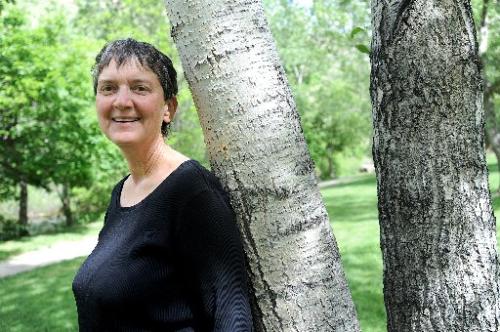Portada del sitio > Fauna > Lyons woman studies how radio waves affect trees

Lyons woman studies how radio waves affect trees
Viernes 16 de julio de 2010 · 1846 lecturas
Lyons woman studies how radio waves affect trees
By Bruce Leaf For the Camera
Posted: 07/04/2010 01:00:00 AM MDT
Katie Haggerty of Lyons, who has no background in science or degrees, recently had a paper about the effects of radio waves on aspen trees accepted by a major academic journal. ( Kira Horvath )
A Lyons area woman with no academic pedigree has published a scientific paper in the International Journal of Forestry Research about the adverse effects of radio waves on aspen seedlings.
Katie Haggerty, who lives north of Steamboat Mountain, found in a preliminary experiment done near her house that aspens shielded from the waves were healthier than those that were not.
"I found that the shielded seedlings produced more growth, longer shoots, bigger leaves and more total leaf area. The shielded group produced 60 percent more leaf area and 74 percent more shoot length than a mock-shielded group," she said.
She began studying electromagnetic fields 20 years ago. In 2005, when she noticed that her geraniums were stunted, she put the plants in a Faraday cage, an enclosure covered by a metal screen that blocks radio frequency energy, and soon found that the plants had larger leaves and were growing more vigorously.
"When I heard about the aspen decline in Colorado, I thought it would be a really good test case for this hypothesis, so I thought, ’OK, I’ll try them,’" Haggerty said. "And the other thing is that people like aspen trees. They’re photogenic and it would get people’s attention if I actually found something."
Thousands of acres of aspen trees in Colorado have died in the past decade, likely due to drought conditions, according to U.S. Forest Service researchers.
The atmosphere is saturated with radio waves from numerous sources, most of which come from daily life in the modern world. Cell phones, radios, televisions, weather radar, microwave ovens and microwave communications are a few of the devices that emit radio waves.
"It’s a stew of various frequencies and signal types," she said.
In spring 2007, she planted the aspen seedlings — one group in a shielded Faraday cage, another group in a cage wrapped in fiberglass that did not block radio waves and a third set was unprotected altogether. By the end of July, there were measureable differences in growth, and at the beginning of October, she noticed differences in coloration.
"The leaves in the shielded group produced striking fall colors, while the two exposed groups stayed light green or yellow and were affected by areas of dead leaf tissue," Haggerty said. "The shielded leaves turned red, which was a good sign. The unshielded leaves in both exposed groups had extensive decay, and some leaves fell off while they were still green.
"It appears that there may be negative effects on the health and growth of aspens from the radio frequency background."
She pointed out that her study was a preliminary experiment that only suggests these effects in aspens and doesn’t prove anything.
"An experiment with multiple repetitions, meaning multiple shielded and mock cages, and statistical analysis of results is needed to test the hypothesis," she said.
Still, her work caught the eye of Wayne Shepperd of the Forest Service’s Rocky Mountain Research Station, who invited her to present her findings at a regional conference on forest decline in Fort Collins in 2008.
"People were interested because someone was looking in a new direction," she said.
The paper was later accepted for presentation at the North American Forest Ecology Workshop at Utah State University in Logan last June. As a result of that presentation, her paper was accepted to be published in a special edition from the workshop of the peer-reviewed online International Journal of Forestry Research.
Journal Editor Terry Sharik, a Utah State University professor, was unaware Haggerty lacked a doctorate or a master’s or even a bachelor’s degree, noting that a researcher’s educational background is not known when a manuscript is submitted for review.
"I suspect that is not very common," he said.
Even though her work is preliminary, Sharik said, "If she turns out to be right following subsequent investigations by others, the results could be very significant and cause people to rethink the current notion that anthropogenic sources of radio waves are fairly harmless to the environment and by extension to humans."
Ver la noticia original AQUÍ







